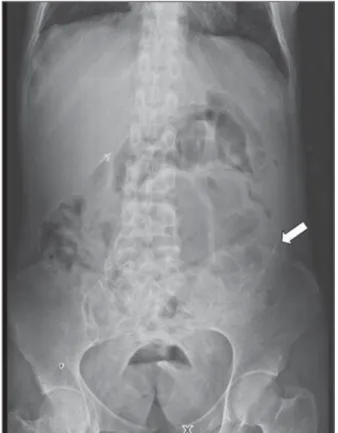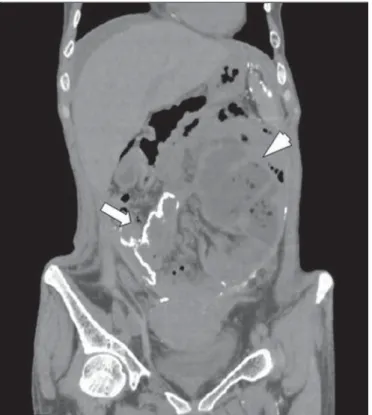Candido PCM et al. / Sclerosing encapsulating peritonitis
Radiol Bras. 2015 Jan/Fev;48(1):56–58 56
0100-3984 © Colégio Brasileiro de Radiologia e Diagnóstico por Imagem
Case Report
Sclerosing encapsulating peritonitis: a case report
*
Peritonite esclerosante encapsulante: relato de caso
Candido PCM, Werner AF, Pereira IMF, Matos BA, Pfeilsticker RM, Silva Filho R. Sclerosing encapsulating peritonitis: a case report. Radiol Bras. 2015 Jan/Fev;48(1):56–58.
Abstract
R e s u m o
Sclerosing encapsulating peritonitis, a rare cause of bowel obstruction, was described as a complication associated with peritoneal dialysis which is much feared because of its severity. The authors report a case where radiological findings in association with clinical symptoms have allowed for a noninvasive diagnosis of sclerosing encapsulating peritonitis, emphasizing the high sensitivity and specificity of computed tomography to demonstrate the characteristic findings of such a condition.
Keywords: Sclerosing encapsulating peritonitis; Peritoneal dialysis; Peritoneal fibrosis; Intestinal obstruction; Computed tomography; Chronic renal failure.
Peritonite esclerosante encapsulante, causa rara de obstrução intestinal, foi descrita como uma complicação associada à diálise perito-neal, muito temida por sua gravidade. Relata-se um caso em que os achados radiológicos associados aos sintomas clínicos permitiram o diagnóstico não invasivo de peritonite esclerosante encapsulante, destacando-se a alta sensibilidade e especificidade da tomografia computadorizada na demonstração dos achados característicos.
Unitermos: Peritonite esclerosante encapsulante; Diálise peritoneal; Fibrose peritoneal; Obstrução intestinal; Tomografia computadori-zada; Insuficiência renal crônica.
* Study developed at Hospital Felício Rocho, Belo Horizonte, MG, Brazil. 1. Trainee in Radiology at Hospital Felício Rocho, Belo Horizonte, MG, Brazil. 2. Resident of Radiology at Hospital Felício Rocho, Belo Horizonte, MG, Brazil. 3. Trainees in Radiology at Hospital Felício Rocho, Fellow degrees at Faculdade de Ciências Médicas de Minas Gerais, Belo Horizonte, MG, Brazil.
4. MDs, Radiologists at Hospital Felício Rocho, Belo Horizonte, MG, Brazil. Mailing address: Dra. Paula de Castro Menezes Candido. Hospital Felício Rocho – Setor de Radiologia. Avenida do Contorno, 9530, Barro Preto. Belo Horizonte, MG, Brazil, 0110-934. E-mail:paulacmcandido@yahoo.com.br.
Received September 5, 2013. Accepted after revision January 22, 2014.
Paula de Castro Menezes Candido1, Andrea de Freitas Werner2, Izabela Machado Flores Pereira3, Breno Assunção Matos3, Rudolf Moreira Pfeilsticker4, Raul Silva Filho4
http://dx.doi.org/10.1590/0100-3984.2013.1909 INTRODUCTION
Sclerosing encapsulating peritonitis is a rare cause of bowel obstruction and is characterized by the presence of a thick fibrotic membrane partially or completely involving the small bowel(1). This condition was described as a
dis-ease associated with peritoneal dialysis in 1978 and, despite its rarity, is a feared complication because of its severity(2).
Radiological findings in association with clinical symp-toms allow a noninvasive diagnosis, and computed tomog-raphy (CT) is the most sensitive and specific imaging mo-dality to demonstrate characteristic findings(3,4).
CASE REPORT
A female, 43-year-old patient who had undergone renal transplantation in 2002 with immediate postoperative graft failure, when peritoneal dialysis was initiated. In 2011, the patient was admitted presenting abdominal pain and disten-sion, decreased in dialytic process efficiency and occasional presence of blood in the dialysis effluent. Abdominal radi-ography showed subtle linear calcifications in areas of bowel
loops (Figure 1). CT revealed the presence of gross linear calcifications corresponding to thickening and calcification of intestinal and peritoneal walls in association with distended
Candido PCM et al. / Sclerosing encapsulating peritonitis
Radiol Bras. 2015 Jan/Fev;48(1):56–58 57
bowel loops with fluid and air contents in the central region of the abdomen (Figures 2, 3 and 4). In 2012, the patient was admitted presenting vomiting, abdominal distension and pain, and underwent surgery, progressing with fistulas, he-modynamic instability and death, with diagnosis of scleros-ing encapsulatscleros-ing peritonitis presumed from the classical clinical and radiological findings.
DISCUSSION
Sclerosing encapsulating peritonitis, described by Owtschinnikow in 1907, is classified into idiopathic or
sec-ondary. The secondary presentation has been reported mainly in association with continuous peritoneal dialysis(1).
Peritoneal dialysis is a therapeutic modality for renal failure that presents several advantages. However, its long-term efficacy is limited by complications, from the most common one, such as bacterial peritonitis, to the most se-vere – sclerosing encapsulating peritonitis –, whose incidence ranges from 0.9% to 7.3%(5).
The main potential risk factors for development of scle-rosing encapsulating peritonitis are the peritoneal dialysis duration and occurrence of repeated episodes of peritoni-tis(3,5,6). In spite of the decline in its incidence in the last two decades, due mainly to the utilization of more biocompatible solutions, the survival associated with scle-rosing encapsulating peritonitis remains extremely low(4).
The classification system proposed by Kawanishi et al., based on clinical and pathological results, divides scleros-ing encapsulatscleros-ing peritonitis into four phases, as follows: pre-sclerosing encapsulating peritonitis, inflammatory phase, progressive phase, and fibrotic phase. Initially, the symptoms are nonspecific (fever, ascites, weight loss, anorexia and bowel habit alteration), indicating the presence of an initial inflam-matory process. With the disease progression, ileal symptoms arise(4). If sclerosing encapsulating peritonitis develops even during peritoneal dialysis, signs such as bloody effluents, recurrent peritonitis episodes and ultrafiltration problems may occur. The occurrence of frequent episodes of bowel obstruction indicates the onset of the fibrotic phase(4). Figure 2. Axial abdominal CT section demonstrating thickening and calcification
of intestinal and peritoneal walls (arrow).
Figure 3. Coronal abdominal CT section presenting gross calcifications in intes-tinal and peritoneal walls (arrow) and distended bowel loops with fluid and air contents located in the central region of the abdomen (arrowhead).
Candido PCM et al. / Sclerosing encapsulating peritonitis
Radiol Bras. 2015 Jan/Fev;48(1):56–58 58
Although this is a rare complication, bowel obstruction resulting from sclerosing encapsulating peritonitis should be considered in any patient undergoing long-term peritoneal dialysis with recurrent abdominal pain(3). The rate of mor-tality associated with sclerosing encapsulating peritonitis ranges between 43.5% and 78%, and depends on the occur-rence of complications(2), such as partial or complete small
bowel obstruction, small bowel necrosis and enterocutaneous fistulas, which require surgical intervention, with high mor-tality(3).
The diagnosis of sclerosing encapsulating peritonitis has been based on the International Society of Peritoneal Dialy-sis guidelines established in 2005, whose key criteria include presence of ileal obstruction symptoms either with or with-out systemic inflammatory reaction, in association with char-acteristic findings at the radiological investigation(7).
Radiological findings associated with clinical symptoms constitute a noninvasive method to confirm such condition(4).
Amongst the available techniques, CT is the most sensitive and specific to demonstrate characteristic findings(3,4) includ-ing peritoneal thickeninclud-ing (100%), calcifications (70%), peri-toneal enhancement (50%), congregated small bowel loops in the center of the abdomen (60%) and loculated fluid col-lections (90%)(3–5). Despite the diagnostic value of CT, was verified that it is not very useful as a screening method.
Other imaging methods such as abdominal radiography can also aid in the diagnosis demonstrating findings similar to those observed in the present case(2,5); also, barium con-trast study reveals distended loops with decreased and disor-dered peristalsis(2,5) and ultrasonography identifies loculated
ascites(1,2)and a characteristic, uniformly echogenic
pre-visceral membrane anterior to the bowel loops(5). The role
played by magnetic resonance imaging is currently being evaluated, but preliminary data suggest results similar to the ones of CT(8).
As regards the treatment, the therapeutic approach de-pends on the stage of the disease(2). Several treatments have
been proposed, including pharmacological and surgical options, the latter being required in cases of bowel obstruc-tion(1–8). Symptoms recurrence occurs in up to 25% of
pa-tients, generally within 12 to 24 months(4).
REFERENCES
1. Xu P, Chen LH, Li YM. Idiopathic sclerosing encapsulating perito-nitis (or abdominal cocoon): a report of 5 cases. World J Gastroenterol. 2007;13:3649–51.
2. Machado DJB, Romão Jr JE, Sabbaga E, et al. Peritonite esclerosante e encapsulante secundária à diálise peritoneal ambulatorial contínua. J Bras Nefrol. 1999;21:112–23.
3. Choi JH, Kim JH, Kim JJ, et al. Large bowel obstruction caused by sclerosing peritonitis: contrast-enhanced CT findings. Br J Radiol. 2004;77:344–6.
4. Bargman J, Harel Z. Encapsulating peritoneal sclerosis. US Nephrol. 2011;5:71–5.
5. Stuart S, Booth TC, Cash CJC, et al. Complications of continuous ambulatory peritoneal dialysis. Radiographics. 2009;29:441–60. 6. Habib AM, Preston E, Davenport A. Risk factors for developing
encapsulating peritoneal sclerosis in the icodextrin era of peritoneal dialysis prescription. Nephrol Dial Transplant. 2010;25:1633–8. 7. Kawanishi H, Moriishi M. Encapsulating peritoneal sclerosis:
pre-vention and treatment. Perit Dial Int. 2007;27 Suppl 2:S289–92. 8. Guest S. Hypothesis: gender and encapsulating peritoneal sclerosis.

